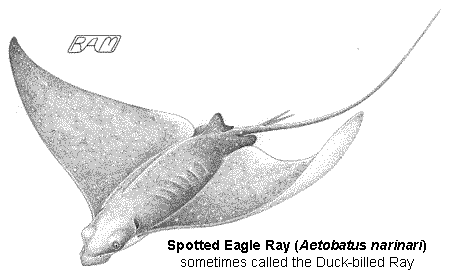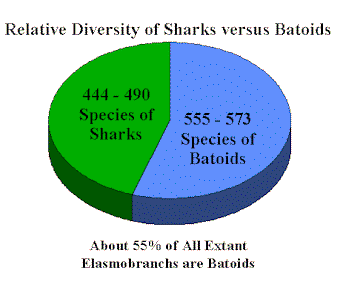Bully for Batoids!
Many people speak of sharks and rays as though they were fundamentally different creatures. Yet there are no biologically compelling reasons for doing so.

Skates and rays most obviously differ from most sharks in being flattened dorsoventrally (from top-to-bottom) and in having enlarged, wing-like pectoral fins attached to the sides of the head. But there are flattened sharks, too — such as the angel and wobbegong sharks (families Squatinidae and Orectolobidae, respectively) — many of which have large, wing- or paddle-like pectoral fins (though never attached to the sides of the head). Most skates and rays rely on wave-like undulations of their pectoral fins to propel them though the water. But there are a few notable exceptions — such as the torpedo rays (order Torpediniformes) and the guitarfishes (orders Rhiniformes and Rhynchobatiformes) — which swim primarily by employing a shark-like sculling motion of the caudal fin. Skates and rays also differ from sharks by having their gill slits located underneath the head, rather than at the sides of the head as in sharks. They breathe instead by drawing in water through paired openings (called spiracles) on top of the head, behind the eyes. Many bottom-dwelling sharks, such as angel sharks and wobbegongs, also have well developed spiracles. But such differences are trivial. In every important biological sense, all these creatures are united by a common basic structure. And — most importantly — sharks, skates, and rays are all derived from a common ancestor.
 Thus, skates and rays are not merely related to
sharks, they are sharks. These 'pancake sharks' are a highly successful
variation on the basic shark body plan, represented today by more than 550
species. Collectively termed 'batoids', these include deep-sea skates,
electricity-generating torpedo rays, venom-barbed stingrays,
chainsaw-nosed sawfishes, bottom-grubbing eagle rays, pelagic
planktivorous manta rays, and the ambiguous-looking guitarfishes. More
than any other batoid, guitarfishes resemble an intermediate form between
a shark and a ray — which, in a manner of speaking, they are. The
characteristic flattened shape and enlarged pectoral 'wings' of batoids
are adaptations to their bottom-associated lifestyle.
Thus, skates and rays are not merely related to
sharks, they are sharks. These 'pancake sharks' are a highly successful
variation on the basic shark body plan, represented today by more than 550
species. Collectively termed 'batoids', these include deep-sea skates,
electricity-generating torpedo rays, venom-barbed stingrays,
chainsaw-nosed sawfishes, bottom-grubbing eagle rays, pelagic
planktivorous manta rays, and the ambiguous-looking guitarfishes. More
than any other batoid, guitarfishes resemble an intermediate form between
a shark and a ray — which, in a manner of speaking, they are. The
characteristic flattened shape and enlarged pectoral 'wings' of batoids
are adaptations to their bottom-associated lifestyle.
Batoids are more speciose than sharks, constituting some 56% of total elasmobranch diversity. Unfortunately, we know very little about the basic life history, ecology, and behavior of most batoids because they have been largely overshadowed by their more infamous cousins. Skates and rays are fascinating creatures in their own right. Despite their low profile, they are as deserving of scientific study, appreciation, and conservation as any other wildlife.
